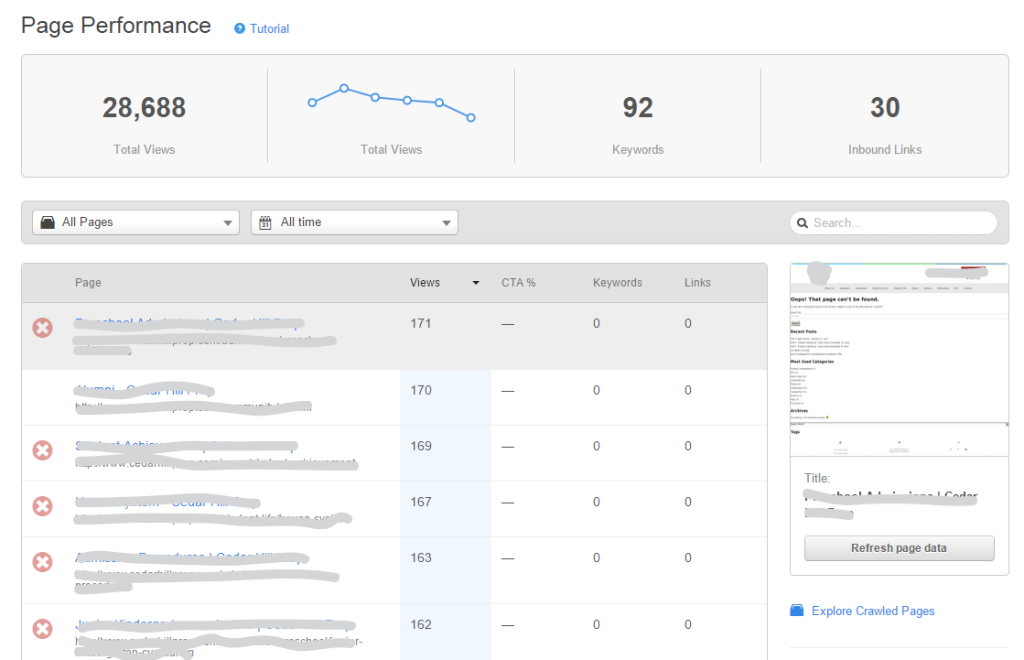How To Perform A Content Audit Using HubSpot
During the holiday break, I spent a bit of time organizing my basement. I am a naturally organized person, so I am sorry to say I did not find any hidden treasures, but I did discover some surprises.
As a family, we are quite busy. We run an inbound marketing agency, but we also have small children that we want to spend quality time with. So we try to save time and shop in bulk for boring things like paper towels or shampoo.
But things don't always get neatly put away, especially when you have tired or hungry toddlers. So, of course, we had some duplicates and some items that I thought were safely stashed away, were already used up.
The same happens to our content, one of our most important long-term business assets that we can build today. We are all busy, preoccupied with the task at hand and content creation sometimes happens on the side.
Just as businesses take inventory of their physical products and assets, we should run a content audit every year.

What Is A Content Audit?
A content audit is a thorough investigation and evaluation of the content on your website. It includes blog posts, website pages, premium content and ideally even looks for content gems stashed away on personal computers or file shares that should be on the website, but aren't.
You can perform a content analysis on the entire website, a subset of the website or just take a sample.
The outcome is a detailed listing of all the content, usually organized on a spreadsheet.
When Should You Do One?
It is a good idea to run an audit once a year.
However, if you are considering a website redesign, the start of an inbound marketing program or an SEO project, a full content audit should be non-negotiable before you start your project. How else would you know what you are dealing with?
What Are The Benefits Of Performing A Content Analysis?
The goal of a content audit is to analyze the quality and quantity of the content, discover gaps and missed opportunities.
- Are you writing for the right buyer persona?
- Do you address your buyer persona's concerns?
- Do you cover all life cycle stages?
- Do your pages have (search engine) on page optimization?
- Do your pages include an appropriate call to action?
Using HubSpot Page Performance Tool To Perform A Content Audit
If you are a lucky HubSpot customer, you have several tools, such as the Page Performance Tool and the Keyword Tool, that will enable you to make a content audit more efficient and more effective.
To start, navigate in your HubSpot portal to Reports > Page Performance. If you have not used this great tool before, I suggest you check it out now.
The HubSpot Page Performance Tool allows you to see how your web pages, landing pages and / or blog posts contribute to your website's success: what pages have been viewed the most or the least, which include a call to action, have the highest or lowest click-through rate, have backlinks and rank for keywords.

Using the page performance tool allows you to conduct a more purposeful content audit, since you can select to only look at your blog posts, web pages or landing pages and then fine tune by a specific timeframe.
This lets you work smart, not hard. Since about 20% of your pages drive about 80% of your traffic, you will want to make sure those top 20% pages are included in your audit.
1) Keyword Research, Buyer Persona Definition
When I sign on a new client, I will perform a content audit in the first 2 months - usually this will go hand-in-hand with fixing some search engine optimization issues that we need to take care of as well. In order to get the maximum benefit, I make sure I have already conducted thorough keyword research and at least one round of buyer persona research.
This way, you can see what pages are ranking for which keywords and you know what you are looking for when conducting the audit.
2) Download Your Crawled Page Information
Depending on your situation, start by selecting a timeframe that makes sense. I chose the previous month since we made significant changes on the website structure for technical reasons the month before.
On the right side half-way down you will see a link saying "Export all pages to Excel". Click that and trigger the download. Once you have received the file, open it.
It will include:
- Page URL
- Title of the page
- Meta Description
- Number of views
- CTA % click-through
- Keywords
- Links to this page
- H1 Count
- Image Count
- Tracking Code Installed
- Author
- Post Date
- Comments
This export right there already saves you HOURS of manual copy & paste work!
Keep that sheet open and add a column Status (Leave as is, Improve, Consolidate, Remove). For the sake of simplicity, I am hiding everything but the URL, title, meta description, status, and comments.
3) Deep Dive Into Your Content
Now go back to your Page Performance Tool and start with the most viewed pages. Click into each page's evaluation and have a look at the HubSpot assessment of your page.

Since I am fixing some basic SEO issues right away, I can click-through to the page from the link on the top of the page, add a call to action and meta-description and come back here and click the "Refresh Page Data" button.
I read the page, look at the formatting, the images and think about what needs to be changed on the page. I ask myself:
- How does this page fit in my buyer's persona's buyer's journey through my website?
- Does this answer all the question a person visiting this page might have?
- Is there any critical information missing?
- Are there visuals that would better get the point across?
- Does this page need to be broken up into subpages?
- How does it fit into the overall navigational structure of the website?
- Is the call to action still relevant or does it need to be replaced?
- Is the information redundant and needs to be consolidated?
- Is the information completely outdated to the point it needs to be removed?
I record any comments or suggested action item I want to address at a later point in time as well as any changes I made.
4) Identify Problems & Gaps
After you get through all that boring work, don't stop there.
Now, that you have gone through all of your pages and you added all the information to your Excel sheet, you can use conditional formatting to highlight the items that need improving, removing or consolidating. You should have a thorough understanding of what content you have, how it is performing and what needs to be changed.
But you still have not addressed possible gaps.
Go through your content audit and look at it from your buyer's personas perspective. What problems or concerns does this person have that your content addresses? Is there anything missing? Step out of your shoes for a moment and into theirs. Does the content make sense?
Talk to your sales team and ask them what their most common questions are that they get. What are the obstacles that sales help buyers overcome? Can those be addressed in the website content? Are they there but no one finds them?
This is so important and will make your website exponentially better!
For example, I talked yesterday with an admissions director of a private school we are working with and she said the biggest part of her "sales" process is she gives personal tours to families considering enrolling their child. I asked her where on the website does it mention that parents have the opportunity to ask for a personal tour? It turns out, nowhere.
5) Address Suggested Changes
Now you know what you have to tackle, you can start making those changes right away if there are not too many or you plan them out over the next few months strategically. You can use project management tools like TeamWork or plan out your content editorial calendar-style in Trello.
Whatever you decide, make sure you let people know about it. Schedule some awesome social media posts using your Social Inbox, make your sales team aware of the new content available to them and blog about it. Don't be afraid to show off the great resources you are now providing.
I hope you find this valuable and I would love to hear how your content audit goes!
Share this
You May Also Like
These Related Stories

Why Your Content Marketing Is Failing & What To Do About It: Pt. 3

3 Scary Stories Your Call To Action Buttons Are Telling You

.png?width=250&height=125&name=TrustBuilderLogoWhiteTranspBackgr(250x125%20px).png)

No Comments Yet
Let us know what you think